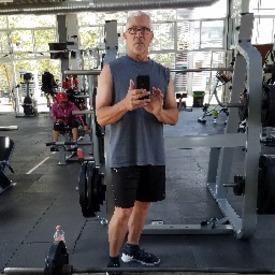Lifting- How many calories burned?
Replies
-
I'd love to see Haybales wade in here as he is very knowledgeable about the design of HRMs but the bottom line is they are not designed to measure calories burned from anything but steady state cardio. There is nothing else you measure with one that will be accurate at all. Heybales can explain why better than I can but it has to do with factoring the HR to the energy burned in an aerobic actvity. As mulitple posters have pointed out, strength training is an anaerobic activity and HRM are pretty much useless.
Those that want to dispute this, help yourself. You are probably sincere and genuine but you are still sincerely and genuinely wrong . The reasons have been laid out in detail.0 -
Theres no point in trying to count them. Unless your doing circuit weight training it isnt much and even then it isnt much. The advantage is the post calorie burn though. Circuit weight training will keep your metabolic rate up longer. Not to mention the added muscle will increase your resting metabolic rate. In short, dont count calories from lifting.0
-
I'd love to see Haybales wade in here as he is very knowledgeable about the design of HRMs but the bottom line is they are not designed to measure calories burned from anything but steady state cardio. There is nothing else you measure with one that will be accurate at all. Heybales can explain why better than I can but it has to do with factoring the HR to the energy burned in an aerobic actvity. As mulitple posters have pointed out, strength training is an anaerobic activity and HRM are pretty much useless.
Those that want to dispute this, help yourself. You are probably sincere and genuine but you are still sincerely and genuinely wrong . The reasons have been laid out in detail.
Yes, they have been.
http://www.myfitnesspal.com/blog/Azdak/view/the-real-facts-about-hrms-and-calories-what-you-need-to-know-before-purchasing-an-hrm-or-using-one-21472
http://www.myfitnesspal.com/blog/Azdak/view/new-hrm-how-to-make-the-calorie-estimate-more-accurate-183102
http://www.myfitnesspal.com/blog/Azdak/view/exercise-calories-sometimes-the-cardio-machines-are-more-accurate-4047390 -
I'd love to see Haybales wade in here as he is very knowledgeable about the design of HRMs but the bottom line is they are not designed to measure calories burned from anything but steady state cardio. There is nothing else you measure with one that will be accurate at all. Heybales can explain why better than I can but it has to do with factoring the HR to the energy burned in an aerobic actvity. As mulitple posters have pointed out, strength training is an anaerobic activity and HRM are pretty much useless.
Those that want to dispute this, help yourself. You are probably sincere and genuine but you are still sincerely and genuinely wrong . The reasons have been laid out in detail.
Yes, they have been.
http://www.myfitnesspal.com/blog/Azdak/view/the-real-facts-about-hrms-and-calories-what-you-need-to-know-before-purchasing-an-hrm-or-using-one-21472
http://www.myfitnesspal.com/blog/Azdak/view/new-hrm-how-to-make-the-calorie-estimate-more-accurate-183102
http://www.myfitnesspal.com/blog/Azdak/view/exercise-calories-sometimes-the-cardio-machines-are-more-accurate-404739
How dare you come in here with real information and cool and collected thoughts. Honestly, thank you.0 -
The only thing missing, and azdak and others have covered this rather well, so I am a little reticent to add to the confusion is that the anaerobic exercise like weight lifting burns calories without a significant change in Oxygen consumption. VO2 (when exhaled air is actually sampled) in these exercises won't provide energy consumption info but it des occur. The body uses two Basic system for these intense but short energy needs ATP-PC and anaerobic glycolysis. Those DOMS we get? Probably due to lactic acid which is an output of anaerobic glycolysis.
Since these are not zero, my solution is to count them at about 230 for 45 minutes. Works for me. (86 kg. ) I have seen tables of estimates based on research but I'm ?? As to the method of evaluation used.0 -
When strength training, I don't worry about calories. I figure that whatever few cal. I may burn while lifting, I just don't get to eat them back. Bonus deficit.0
-
y worry about calories burned during lifting. u lift to get stronger not to burn calories. next, someone is going to post how many calories burned when showering. u shower to get clean, lift to get strong, cardio to burn calories.0
-
You said ORIGINAL question...Original meaning belonging or pertaining to the origin or beginning of something. so the original post was "Is there any surefire way to count the calories that you burn while lifting?"
Please, Continue your brilliance..."Every day, I try to do 30 minutes of cardio and then I move onto the weights, working a different muscle group each day."
Do you see the Cardio AND lifting....If not, I'll buy you some glasses, because I care.
I see cardio AND lifting, but I fail to see cardio WHILE lifting.
Thank you ^^^^ abbabtlm.
There was no question here about if cardio AND lifting was a good choice. SHE ALREADY KNOWS THAT!!! SHES DOING IT ALREADY!!! My point again...she asked about counting calories while lifting. She simply continued and explained what she is doing. You answered a non existent question playing it off as if you were "bringing the topic back to the origin". Which you did not. Brilliance continued. Thanks for recognizing :blushing:0 -
Just incase you didn't see it a bunch on the first page.Wear an HRM for your complete workout. Name it...Moving the Gym forcefully over the trolls.
HRMs are modeled after a constant cardio style activity and are not accurate to weight lifting0 -
by the way a question is easily spotted by the "?" at the end of the sentence. if there isn't one there...there is no question.0
-
I'd love to see Haybales wade in here as he is very knowledgeable about the design of HRMs but the bottom line is they are not designed to measure calories burned from anything but steady state cardio. There is nothing else you measure with one that will be accurate at all. Heybales can explain why better than I can but it has to do with factoring the HR to the energy burned in an aerobic actvity. As mulitple posters have pointed out, strength training is an anaerobic activity and HRM are pretty much useless.
Those that want to dispute this, help yourself. You are probably sincere and genuine but you are still sincerely and genuinely wrong . The reasons have been laid out in detail.
Yes, he showed me a nice doc that showed some of the science behind how the polars work...apparently there was a problem with one of the models for females? Polar S410 maybe? It give a 33% inaccuracy for female cardio burns or something? They pin pointed the problem so I'm assuming it will be fixed in the new models that will come out? Anyway, that polar one research paper specifically said the polars were based on cardio burns, not weight training.
edit: the study has been removed from public viewing on the university of illinios website but the link remains for anyone interested:
http://www.myfitnesspal.com/topics/show/459580-polar-hrm-calorie-burn-estimate-accuracy-study
Abstract:
http://www.ncbi.nlm.nih.gov/pubmed/15292754
Double edit: found it!
"Polar Electro, Inc., is a leading manufacturer of HR monitors. Their instruments have been shown to provide
valid measurements of HR when compared with electrocardiograms"
"When the predicted values of V˙ O2max and HRmax are used, the Polar S410 HRM provides a rough estimate of EE during running, rowing, and cycling"
"The advantage of using HR is that it is a physiological parameter that can detect changes in exercise intensity even when the movement patterns differ greatly. Thus, the HR monitor is able to estimate EE in activities such as rowing and cycling, which do not elicit vertical displacement of the trunk, where pedometers and accelerometers would fail (4,13)."
http://www.researchgate.net/publication/8417411_Accuracy_of_polar_S410_heart_rate_monitor_to_estimate_energy_cost_of_exercise
There's probably some other stuff in there too, that's what I got from a skim. I read a better article along with that one and I cannot for the life of me find it...0 -
I just track it on here under cardio as "strength training"0
This discussion has been closed.
Categories
- All Categories
- 1.4M Health, Wellness and Goals
- 398.2K Introduce Yourself
- 44.7K Getting Started
- 261K Health and Weight Loss
- 176.4K Food and Nutrition
- 47.7K Recipes
- 233K Fitness and Exercise
- 462 Sleep, Mindfulness and Overall Wellness
- 6.5K Goal: Maintaining Weight
- 8.7K Goal: Gaining Weight and Body Building
- 153.5K Motivation and Support
- 8.4K Challenges
- 1.4K Debate Club
- 96.5K Chit-Chat
- 2.6K Fun and Games
- 4.8K MyFitnessPal Information
- 12 News and Announcements
- 21 MyFitnessPal Academy
- 1.6K Feature Suggestions and Ideas
- 3.2K MyFitnessPal Tech Support Questions









